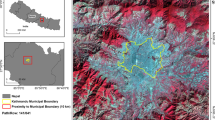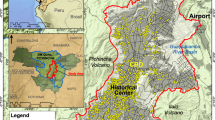Abstract
Scale effects are pervasive in geospatial modeling and affect the reliability of analysis results. This paper examines the neighborhood scale effects on the performance of land loss models in coastal Louisiana where Lower Mississippi River Basin is located. The study incorporates both natural and human variables and their corresponding neighborhood scale variables into land loss modeling. Semivariogram analysis was used to determine each explanatory variable’s neighborhood size at which the semivariance between sample points begins to level off. A new ‘neighborhood’ variable for each of those variables detected with a neighborhood size was created using the focal statistics to represent the neighborhood scale effects. Two land loss stepwise regression models, one without neighborhood variables and the other with neighborhood variables, were developed to test if incorporating neighborhood scale effects could improve the land loss model performance. Results show that the model’s overall accuracy improved significantly from 65.43 to 74.43% after including the neighborhood variables. Six neighborhood variables, in addition to 14 original variables, were selected as significant predictors of land loss probability. The six neighborhood variables include distance to the coastline, land fragmentation, oil and gas well density, percent of water area, pipeline density, and percent of the vacant house. The analysis shows that including variables representing the scale effects are critical for better performance in land loss modeling. Study findings add new insights into the complex land loss mechanism and help derive more accurate land loss predictions to inform coastal restoration and management decision-making.









Similar content being viewed by others
References
Anselin L (1988) Spatial econometrics: methods and models. Springler, Berlin
Blum MD, Roberts HH (2009) Drowning of the mississippi delta due to insufficient sediment supply and global sea-level rise. Nat Geosci 2:488–491
Cai H, Lam NSN, Zou L, Qiang Y, Li K (2016) Assessing community resilience to coastal hazards in the lower mississippi river basin. Water 8(2):46
Cai H, Lam NSN, Zou L, Qiang Y (2018) Modeling the dynamics of community resilience to coastal hazards using a bayesian network. Ann Am Assoc Geogr 108:1260–1279
Cassidy L, Barnes G (2012) understanding household connectivity and resilience in marginal rural communities through social network analysis in the village of Habu, Botswana. Ecol Soci. https://doi.org/10.5751/ES-04963-170411
Chen L, Gao Y, Zhu D et al (2019) Quantifying the scale effect in geospatial big data using semi-variograms. PLoS ONE 14:e0225139
Coastal Protection and Restoration Authority of Louisiana. 2017. Louisiana’s Comprehensive Master Plan for a Sustainable Coast. http://coastal.la.gov/wp-content/uploads/2017/04/2017-Coastal-Master-Plan_Web-Book_CFinal-with-Effective-Date-06092017.pdf
Couvillion BR, Beck H, Schoolmaster D, Fischer M (2017) Land area change in coastal Louisiana (1932 to 2016). U.S. Geological Survey, Reston, VA
Cressie N (1985) Fitting variogram models by weighted least squares. J Int Assoc Math Geol 17(5):563–586
Cressie N, Douglas MH (1980) Robust estimation of the variogram: I. J Int Assoc Math Geol 12(2):115–125
Cutter SL, Burton CG, Emrich CT (2010) Disaster resilience indicators for benchmarking baseline conditions. J Homel Secur Emerg Manage. https://doi.org/10.2202/1547-7355.1732
Day JW, Kemp GP, Freeman A, Muth DP (eds) (2014) Perspectives on the restoration of the mississippi delta: the once and future delta. Springer, Netherlands
Fotheringham AS, Brunsdon C, Charlton M (2002) Geographically weighted regression: the analysis of spatially varying relationships. Wiley, Chichester, UK
Gandhi V (2008) Semivariogram Modeling. In: Shekhar S, Xiong H (eds) Encyclopedia of GIS. Springer, US, Boston, MA, pp 1042–1046
Garrigues S, Allard D, Baret F, Weiss M (2006) Quantifying spatial heterogeneity at the landscape scale using variogram models. Remote Sens Environ 103:81–96
Giosan L, Syvitski J, Constantinescu S, Day J (2014) Climate change: protect the world’s deltas: nature news & comment. Nature 516:31–33
Goodchild MF, Lam NSN (1980) Areal interpolation: a variant of the traditional spatial problem. GeoProcessing 1:297–312
Goodchild MF, Mark DM (1987) The fractal nature of geographic phenomena. Ann Assoc Am Geogr 77:265–278
Gräler B, Pebesma E, Heuvelink G (2016) Spatio-Temporal Interpolation using gstat. The R Journal 8:204–218
Hepinstall JA, Alberti M, Marzluff JM (2008) Predicting land cover change and avian community responses in rapidly urbanizing environments. Landscape Ecol 23:1257–1276. https://doi.org/10.1007/s10980-008-9296-6
Hohn ME (1999) The semivariogram. In: Hohn ME (ed) Geostatistics and petroleum geology. Springer, Netherlands, Dordrecht, pp 15–80
Homer CH, Fry JA, Barnes CA (2012) The national land cover database. US Geolog Surv Fact Sheet 3020(4):1–4
Journal AG, Huijbregts CJ (1978) Mining Geostatistics. Academic Press, New York
Lam NSN (1983) Spatial interpolation methods: a review. The Am Cartogr 10(2):129–149
Lam NSN (2012) Geospatial methods for reducing uncertainties in environmental health risk assessment: challenges and opportunities. Ann Assoc Am Geogr 102(5):942–950
Lam NSN (2019) Resolution. In: Wilson JP (ed) The geographic information science & technology body of knowledge (2nd Quarter 2019 Edition). https://doi.org/10.22224/gistbok/2019.2.11
Lam NSN, Quattrochi DA (1992) On the issues of scale, resolution, fractal analysis in the mapping sciences. Prof Geogr 44(1):89–99
Lam NSN, Quattrochi DA, Qiu HL, Zhao W (1998) Environmental assessment and monitoring with image characterization and modeling system using multiscale remote sensing data. Appl Geographic Stud 2(2):77–93
Lam NSN, Qiu HL, Quattrochi DA, Emerson CW (2002) An evaluation of fractal methods for characterizing image complexity. Cartogr Geogr Inf Sci 29(1):25–35
Lam NSN, Catts D, McMaster R, Quattrochi D, Brown D (2005) Scale. In: Mcmaster R, Usery L (eds) A research agenda for geographic information science. CRC Press, Bacon Raton
Lam NSN, Xu YJ, Liu KB, Dismukes DE, Reams M, Pace RK, Qiang Y, Narra S, Li K, Bianchette TA, Cai H, Zou L, Mihunov V (2018a) Understanding the mississippi river delta as a coupled natural-human system: Research methods, challenges, and prospects. Water 10(8):1054
Lam NSN, Cheng W, Zou L, Cai H (2018b) Effects of landscape fragmentation on land loss. Remote Sens Environ 209:253–262
LeSage JP, Pace RK (2009) Introduction to spatial economics. Chapman and Hall, Routledge
Li K, Lam NSN (2018) A spatial dynamic model of population change in a vulnerable coastal environment. Int J Geograph Info Sci 32(4):685–710
Overmars KP, de Koning GHJ, Veldkamp A (2003) Spatial autocorrelation in multi-scale land use models. Ecol Model 164:257–270
Qiang Y, Lam NSN (2015) Modeling land use and land cover changes in a vulnerable coastal region using artificial neural networks and cellular automata. Environ Monit Assess 187:57
Qiang Y, Lam NSN (2016) The impact of Hurricane Katrina on urban growth in Louisiana: an analysis using data mining and simulation approaches. Int J Geogr Inf Sci 30:1832–1852
Roy S, Robeson SM, Ortiz AC, Edmonds DA (2020) Spatial and temporal patterns of land loss in the lower mississippi river delta from 1983 to 2016. Remote Sens Environ 250:112046
Shu Y, Lam NSN, Reams M (2010) A new method for estimating carbon dioxide emissions from transportation at fine spatial scales. Environ Res Lett 5(4):044008
Smith GJ (2005) Depicting coastal Louisiana land loss. U.S. Geological Survey, Reston, VA
Syvitski JPM, Kettner AJ, Overeem I et al (2009) Sinking deltas due to human activities. Nat Geosci 2:681–686
Tibbetts J (2006) Louisiana’s wetlands: a lesson in nature appreciation. Environ Health Perspect 114:A40–A43
Twilley RR, Bentley SJ, Chen Q et al (2016) Co-evolution of wetland landscapes, flooding, and human settlement in the Mississippi River Delta Plain. Sustain Sci 11:711–731
Zhao B, Cai Q (2004) Geostatistical analysis of chlorophyll a in freshwater ecosystems. J Freshw Ecol 19:613–621
Zhao Y, Cui B, Murayama Y (2011) Characteristics of neighborhood interaction in urban land-use changes: a comparative study between three metropolitan areas of Japan. J Geogr Sci 21:65–78
Zou KH, O’Malley AJ, Mauri L (2007) Receiver-operating characteristic analysis for evaluating diagnostic tests and predictive models. Circulation 115:654–657
Zou L, Kent J, Lam NSN, Cai H, Qiang Y, Li K (2016) Evaluating land subsidence rates and their implications for land loss in the Lower Mississippi River Basin. Water 8(1):10
Funding
Information that explains whether and by whom the research was supported. The work was supported by the grant from the U.S. National Science Foundation under the Dynamics of Coupled National Human Systems (CNH) Program (#1,212,112). Any opinions, findings, and conclusions, or recommendations expressed in this material are those of the authors and do not necessarily reflect the views of the funding agencies.
Author information
Authors and Affiliations
Corresponding author
Ethics declarations
Conflict of interest
The authors declare that they have no conflict of interest.
Additional information
Publisher's Note
Springer Nature remains neutral with regard to jurisdictional claims in published maps and institutional affiliations.
Rights and permissions
About this article
Cite this article
Cai, H., Lam, N.S.N. & Zou, L. Incorporating neighborhood scale effects into land loss modeling using semivariograms. J Geogr Syst 24, 419–439 (2022). https://doi.org/10.1007/s10109-021-00372-4
Received:
Accepted:
Published:
Issue Date:
DOI: https://doi.org/10.1007/s10109-021-00372-4




